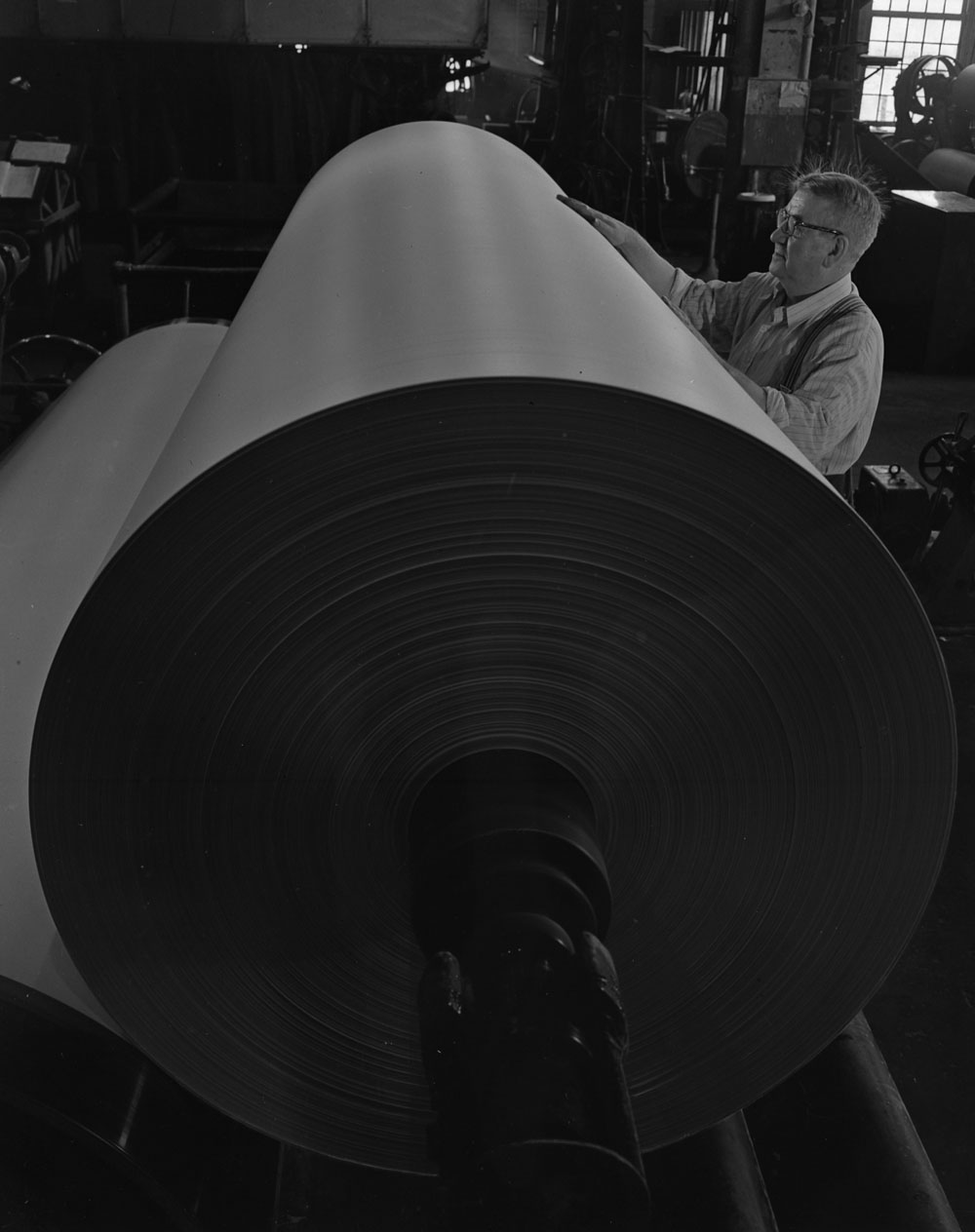Browse "Industry"
-
Article
NOVA Corporation
NOVA Corporation was a Canadian energy company based in Calgary. Originally known as the Alberta Gas Trunk Line Company Ltd., it was established in 1954 to build, own and operate Alberta’s natural gas gathering and transmission facilities. In 1998, NOVA merged with TransCanada (now TC Energy), creating the fourth largest gas pipeline company in North America.
"https://development.thecanadianencyclopedia.ca/images/tce_placeholder.jpg?v=e9dca980c9bdb3aa11e832e7ea94f5d9" // resources/views/front/categories/view.blade.php
https://development.thecanadianencyclopedia.ca/images/tce_placeholder.jpg?v=e9dca980c9bdb3aa11e832e7ea94f5d9
-
Article
One Big Union
The One Big Union (OBU) was a radical labour union formed in Western Canada in 1919. It aimed to empower workers through mass organization along industrial lines. The OBU met fierce opposition from other parts of the labour movement, the federal government, employers and the press. Nevertheless, it helped transform the role of unions in Canada. Click here for definitions of key terms used in this article.
"https://d2ttikhf7xbzbs.cloudfront.net/media/new_article_images/OneBigUnion/OBU_logo.JPG" // resources/views/front/categories/view.blade.php
https://d2ttikhf7xbzbs.cloudfront.net/media/new_article_images/OneBigUnion/OBU_logo.JPG -
Article
Pay Television
Although undertaken experimentally in Etobicoke, Ontario, between 1960 and 1965, pay television as a major venture was licensed only in March 1982, after a decade of debate.
"https://development.thecanadianencyclopedia.ca/images/tce_placeholder.jpg?v=e9dca980c9bdb3aa11e832e7ea94f5d9" // resources/views/front/categories/view.blade.php
https://development.thecanadianencyclopedia.ca/images/tce_placeholder.jpg?v=e9dca980c9bdb3aa11e832e7ea94f5d9
-
Article
Petro-Canada
Petro-Canada, created by the federal government in the mid-1970s as Canada's national oil company, was the offspring of the world energy crisis, Canadian ECONOMIC NATIONALISM, and a tradition of state-supported development of the country's costly energy frontier.
"https://development.thecanadianencyclopedia.ca/images/tce_placeholder.jpg?v=e9dca980c9bdb3aa11e832e7ea94f5d9" // resources/views/front/categories/view.blade.php
https://development.thecanadianencyclopedia.ca/images/tce_placeholder.jpg?v=e9dca980c9bdb3aa11e832e7ea94f5d9
-
Article
Petrochemical Industry
The petrochemical industry, which produces chemicals using OIL AND NATURAL GAS as major raw materials, occupies an important position in Canada's MANUFACTURING and consuming sectors. Oil and natural gas are composed primarily of hydrocarbons. Most petrochemicals contain hydrogen or carbon or both.
"https://development.thecanadianencyclopedia.ca/images/tce_placeholder.jpg?v=e9dca980c9bdb3aa11e832e7ea94f5d9" // resources/views/front/categories/view.blade.php
https://development.thecanadianencyclopedia.ca/images/tce_placeholder.jpg?v=e9dca980c9bdb3aa11e832e7ea94f5d9
-
Article
Petroleum
Since its first commercial exploitation in the 1850s, petroleum has become the major energy source of Canada and the industrial world.
"https://d2ttikhf7xbzbs.cloudfront.net/media/media/b1bdae25-5b0f-46c9-b9d1-47b72ddc49ba.jpg" // resources/views/front/categories/view.blade.php
https://d2ttikhf7xbzbs.cloudfront.net/media/media/b1bdae25-5b0f-46c9-b9d1-47b72ddc49ba.jpg
-
Article
Petroleum Exploration and Production
People did not start drilling for buried petroleum until the middle of the 19th century, though its existence had been known for centuries.
"https://d2ttikhf7xbzbs.cloudfront.net/media/media/f1e8c0f7-6bb9-42eb-95c7-514e096bef49.jpg" // resources/views/front/categories/view.blade.php
https://d2ttikhf7xbzbs.cloudfront.net/media/media/f1e8c0f7-6bb9-42eb-95c7-514e096bef49.jpg
-
Article
Petroleum Industries
Petroleum industries find, produce, process, transport, refine and market petroleum commodities.
"https://d2ttikhf7xbzbs.cloudfront.net/media/media/5ceeeefa-12aa-419d-91aa-b6c959804761.jpg" // resources/views/front/categories/view.blade.php
https://d2ttikhf7xbzbs.cloudfront.net/media/media/5ceeeefa-12aa-419d-91aa-b6c959804761.jpg
-
Article
Petroleum Research and Development
Research has always been the backbone of the petroleum industry. Bringing crude oil, bitumen or natural gas to the surface presents major technological problems and, once recovered, there is little use for the resource in its raw state.
"https://development.thecanadianencyclopedia.ca/images/tce_placeholder.jpg?v=e9dca980c9bdb3aa11e832e7ea94f5d9" // resources/views/front/categories/view.blade.php
https://development.thecanadianencyclopedia.ca/images/tce_placeholder.jpg?v=e9dca980c9bdb3aa11e832e7ea94f5d9
-
Article
Petroleum Supply and Demand
Petroleum demand reflects energy use in society and is usually forecast by projecting recent trends in economic growth, energy consumption, petroleum technology and prices.
"https://development.thecanadianencyclopedia.ca/images/tce_placeholder.jpg?v=e9dca980c9bdb3aa11e832e7ea94f5d9" // resources/views/front/categories/view.blade.php
https://development.thecanadianencyclopedia.ca/images/tce_placeholder.jpg?v=e9dca980c9bdb3aa11e832e7ea94f5d9
-
Article
Pipeline Debate, 1956
The Pipeline Debate, 8 May-6 June 1956, was one of the most famous confrontations in Canadian parliamentary history.
"https://d2ttikhf7xbzbs.cloudfront.net/media/media/5b52b570-6e9b-476a-94a9-af4ca135ac51.jpg" // resources/views/front/categories/view.blade.php
https://d2ttikhf7xbzbs.cloudfront.net/media/media/5b52b570-6e9b-476a-94a9-af4ca135ac51.jpg
-
Article
Print Industry
Prior to the printing process of putting impressions on paper, foil, plastic or cloth, there are pre-press procedures such as design, artwork, layout, creation of type or graphics, film and platemaking, and press makeready. In the past all these processes were done by hand or camera.
"https://d2ttikhf7xbzbs.cloudfront.net/media/media/5177ea5a-5977-4f69-832c-20bdf5fc2d60.jpg" // resources/views/front/categories/view.blade.php
https://d2ttikhf7xbzbs.cloudfront.net/media/media/5177ea5a-5977-4f69-832c-20bdf5fc2d60.jpg
-
Article
Pulp and Paper Industry
The pulp and paper industry consists of manufacturing enterprises that convert predominantly woody plant material into a wide variety of pulps, papers and paperboards. The Canadian industry began in the 1800s and has undergone revolutionary changes over the years. Most recently, the move from newsprint to electronic media caused the industry to decline; however, pulp and paper remains a fundamental part of the Canadian economy, especially for remote and northern communities.
"https://d2ttikhf7xbzbs.cloudfront.net/pulpandpaper/paperrole.jpg" // resources/views/front/categories/view.blade.php
https://d2ttikhf7xbzbs.cloudfront.net/pulpandpaper/paperrole.jpg
-
Article
Quill & Quire
Quill & Quire is a magazine of the Canadian book trade. It is read chiefly by publishers, booksellers, librarians, writers and educators. Founded by the Seccombe family in 1935, it was a monthly magazine serving stationers and booksellers.
"https://development.thecanadianencyclopedia.ca/images/tce_placeholder.jpg?v=e9dca980c9bdb3aa11e832e7ea94f5d9" // resources/views/front/categories/view.blade.php
https://development.thecanadianencyclopedia.ca/images/tce_placeholder.jpg?v=e9dca980c9bdb3aa11e832e7ea94f5d9
-
Macleans
Random House/Doubleday Merger
David Kent is in a combative mood. Seated at the desk in his book-lined corner office, the 48-year-old president of Random House Canada, a Toronto-based publisher, is taking calls and returning messages from business associates and journalists.This article was originally published in Maclean's Magazine on February 1, 1999
"https://development.thecanadianencyclopedia.ca/images/tce_placeholder.jpg?v=e9dca980c9bdb3aa11e832e7ea94f5d9" // resources/views/front/categories/view.blade.php
https://development.thecanadianencyclopedia.ca/images/tce_placeholder.jpg?v=e9dca980c9bdb3aa11e832e7ea94f5d9

